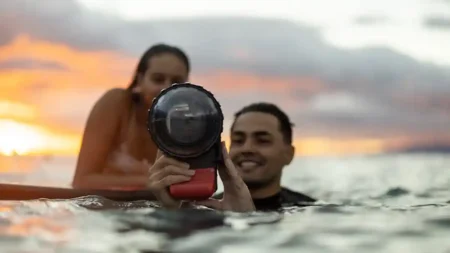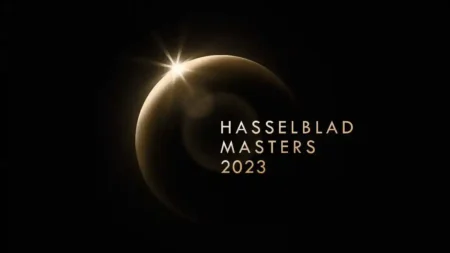My first proper shooting opportunity with the Canon EOS R3 was at a rugby match, which meant I was able to give the autofocus, Subject tracking and Eye Control AF a good test. It was immediately apparent that the R3’s focusing system is very fast and accurate.
Also, with the ‘Subject to detect’ set to ‘People’ and the Eye detection enabled, the camera very quickly identified players in the frame and when they were within a reasonable distance their head and then an eye become the point of focus.
I was photographing a fast, intense game with lots of diagonal runs, players passing each other and, of course, tackles. The R3 took it all in its stride but I found all the action quite distracting when I tried to set the subject with my eye. I got better at it with practise, but I found ‘Expand AF area: Around’ easier to use. And generally, I only need to set a fairly central point and direct it at my main target, then the camera would latch onto it and stick with the subject extremely well. And if the AF point didn’t start over a subject, they camera usually quickly spotted the clearest person and focused on them, throwing a blue square or rectangle around their body, head, face or eye.
I shot with the Servo AF set to ‘Case A’ in which the tracking automatically adapts to the subject movement and I left ‘Switching tracked subjects’ in it’s default setting of 1, the mid-way point between the extremes of 0 and 2. Even so, the camera stayed pretty well with my intended subject when someone came between it and the camera. And when there was something other than a human between the camera and the subject, such as the rugby posts, it continued to stay with the player, not seeming remotely tempted to switch subject. It meant that I could shoot from behind the posts and not worry at about them distracting the focusing system.
Scroll down to see images from the rugby match.
I enlisted the help of a friend with a Royal Enfield motorbike to test the R3’s vehicle detection and tracking. Again it worked well but there were a few occasions when the blue square that indicates the detected subject suddenly jumped away from the bike and onto the road. This tended to be when the biked wasn’t completely square on to the camera but it still had a very slim profile with little of the side of the bike showing. As the bike got closer and more of its side became visible, the camera spotted it again the block box jumped around the bike.
As the motor bike got closer, the blue box would jump from the bike to the rider’s helmet and visor.
Again, I shot with the Servo AF set to ‘Case A’ and the other options in their default settings, and with the camera left to decide which of the AF points to select there was only a very short delay after the motorbike appeared around a bend before the camera threw a blue box around it and got it sharp. Using the Eye Control AF and looking at the point where the bike was about to appear didn’t make a noticeable difference to the speed of subject acquisition.
I also had the opportunity to photograph a variety of birds and my dog with the R3’s subject detection set to ‘Animal’. When the birds were on the ground or water, the camera often recognised then but didn’t always pick up their eye. Interestingly, with a robin, it spotted an eye quicker when the bird was facing me rather than side on with more of the eye visible. The speed of recognition of a bird in flight, however, is incredibly quick and even tough I was shooting in very poor light, it targeted their eyes very well.
I’m also very impressed by how well the R3 was able to detect my dog’s eyes. He’s pretty fuzzy so his eyes aren’t the clearest – although he has quite bushy eyebrows which may help with the identification. The R3 was able to spot him even when he was small in the frame and quickly put the focus on his eyes as he ran towards me. It’s not just the fact that it can detect his eyes that impresses, it’s the fact that it can do it with such speed and keep up with him as he races around. It gives Canon R3 users a huge advantage for pet and wildlife photography!
Although a CFexpress card is required to be able to shoot raw video at the highest frame rate, you can shoot stills at 30fps when a fast USH-II SD card is in the R3’s slot. In fact, while the figures vary a little from sequence to sequence, I was able to get around 387 top-quality large Jpegs in a continuous blast with a CFexpress card in place and around 390 to 440 when I used an SD card. Switching to shoot raw and Jpeg files continuously dropped the count to around 130 images with a CFexpress card but the rate stayed at 30fps.
Eye Control AF
With less frenetic subjects than rugby to photograph, the Eye Control AF can provide a fast and intuitive way of switching between subjects, but I didn’t have 100% success with it. In most instances, the cursor moved over my intended subject, but not always. I also had more success when using my naked eye rather than when wearing my glasses. However, my glasses are varifocals and I’m pretty sure that they’re not always over the same part of my eye, which would increase the challenge that the Eye control faces.
As I mentioned earlier, I made two calibrations of the Eye control for the R3, one with and one without my specs. I refined both calibrations a few times and the system worked better for me – or I got more used it. However, there are still times when it’s inappropriate. For example, when I photographed a statue of human/goat hybrid, the camera didn’t recognise its face or eyes. I found it impossible to set the AF point to a small area over an eye using the Eye Control AF. Instead, I had to switch to 1-point AF mode, but thankfully you can turn the Eye Control AF off and on with the press of a button.
When using the Eye Control AF, I stuck with the default set-up which means that once activated, the Eye Control AF was started by the shutter release button. This means that whatever you’re looking at when you press the shutter release should be detected as the subject and the camera will continue to track it for as long as you hold the shutter release down. If you want to switch to a different subject, you just need to lift your finger momentarily, look at the new subject and depress the button again.
Canon EOS R3 image quality
Canon has given the EOS R3 a native sensitivity range of ISO 100-102,400 for stills and if I needed to capture an image in conditions that demanded the highest value, I’d happily use the ISO 102,400 setting. At that value the raw files have noticeable luminance noise but it’s fine-grained and is evenly distributed with no banding or false colour evident. Jpegs captured at the same ISO setting and the default noise reduction settings show little sign of noise but some areas look at bit softer than I’d like. As you’d expect, dropping down to ISO 51,200 produces better results, but ideally, I’d aim to use ISO 25,600 or lower.
Jpegs shot at ISO 25,600 look good when sized to fill a 27-inch screen, however, being hyper-critical, it’s worth shooting raw files when the sensitivity gets above around ISO 6,400 as some finer details are lost in the Jpegs.
Exposure and colour
In its default settings, the Canon EOS R3 produces colours that are typically Canon, by which I mean they are fairly vibrant and attractive. The Auto White Balance setting also does a good job of delivering images that look natural but not too neutral. Even in very overcast conditions, I didn’t feel compelled to shoot in the Cloudy or Shade setting to give images a bit more life.
The on-board Picture Styles are useful for adjusting the colour to suit the conditions, but I usually stick with Standard as it’s a good all-rounder, or Neutral if I want something a bit more natural. I find Landscape makes greens look too verdant. That said, I also always shoot raw files so I have the maximum level of control available over the look of my final images.
Canon EOS R3 video performance
It’s not currently possible to record raw video from the R3 to an Atomos Ninja V or Ninja V+, which means you have to record internally. However, shooting at 50p fills a 128GB CFexpress card in less than 9 minutes, which limits its usability.
Changing to record 4K-D All-I MP4 video at 50P extends the duration to around 20 minutes before a 128GB CFexpress card is full. The camera also heats up noticeably, but it didn’t cut-out in that time.
The quality of the video reflects those of the stills and the superb subject detection and tracking system makes it easy to ensure that the subject is sharp.
The Canon R3’s image stabilisation system works in video mode as well as when shooting stills and it makes handheld footage rock-steady. I’ve yet to post any clips, but it looks like the camera is mounted on a tripod when I’m hand-holding it.
You can order the Canon EOS R3 from Adorama in the USA.



